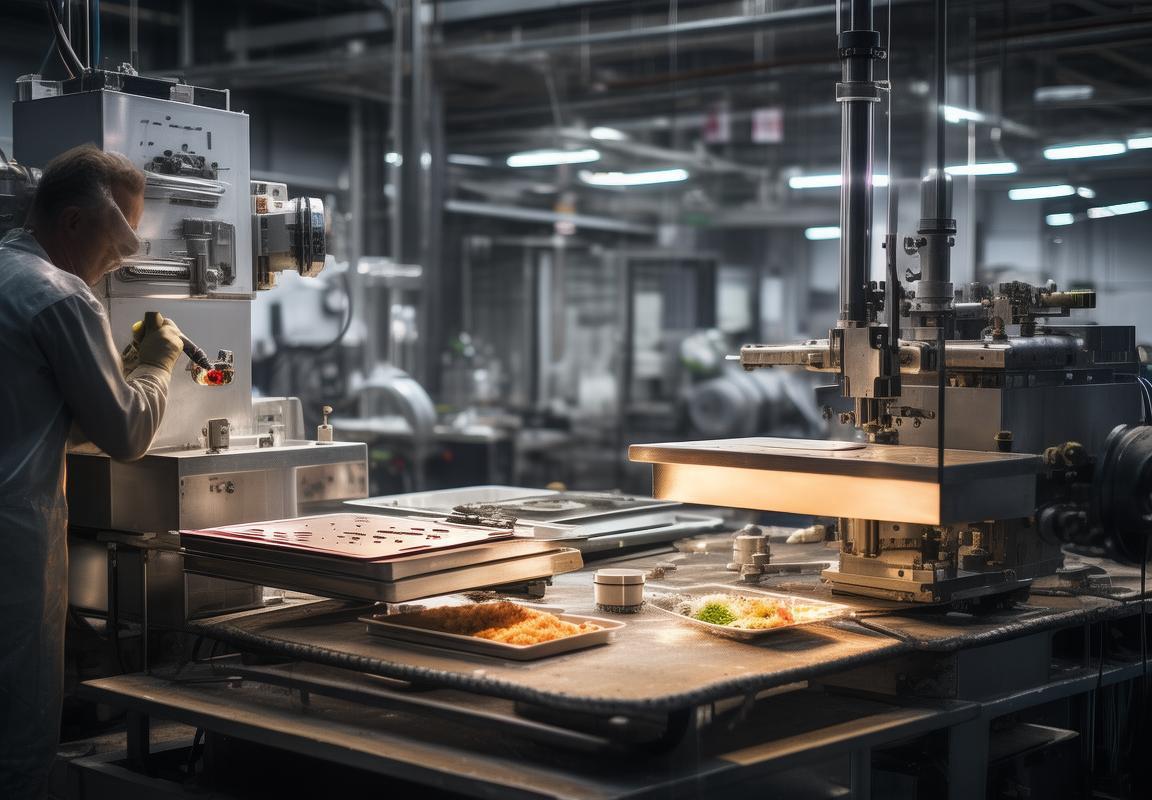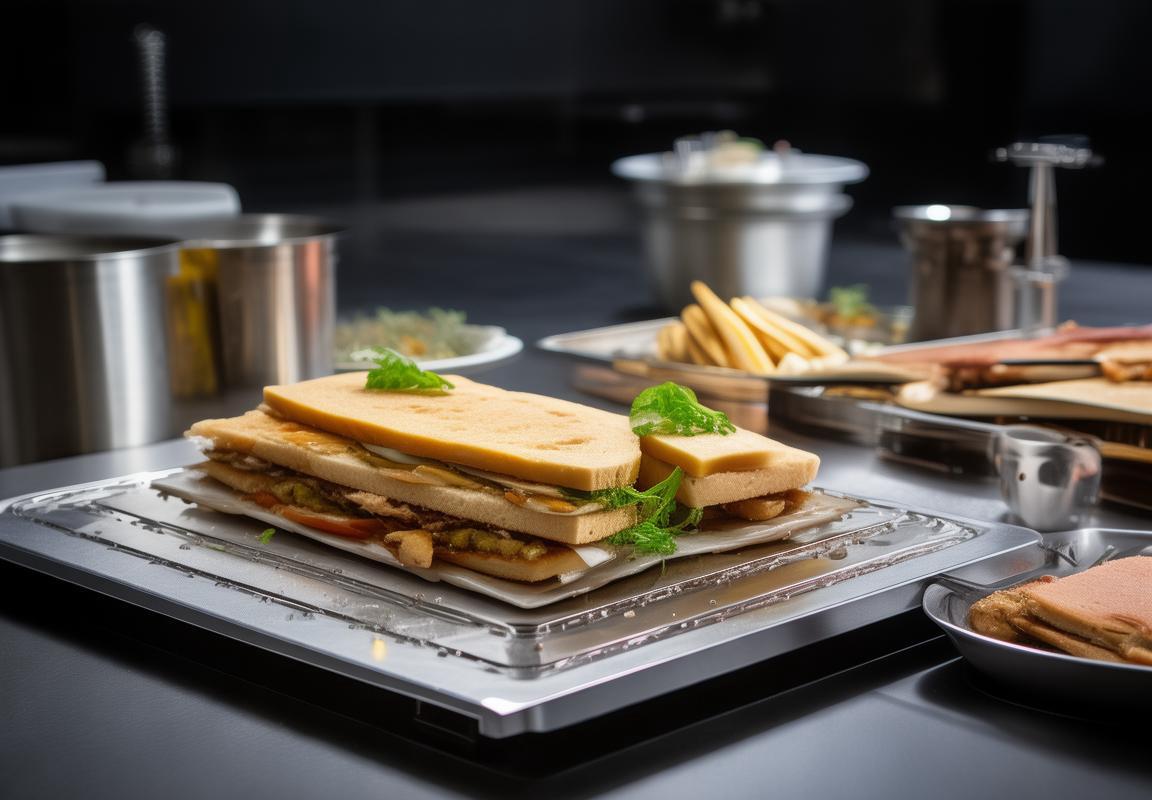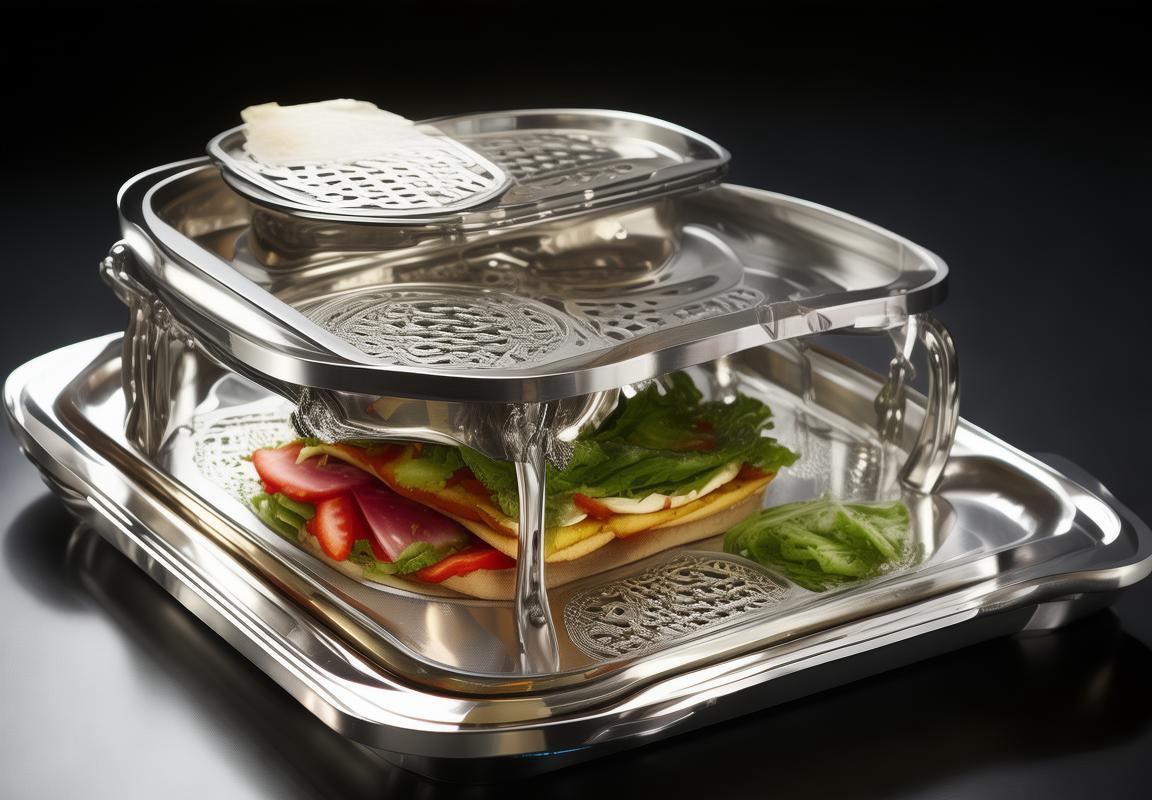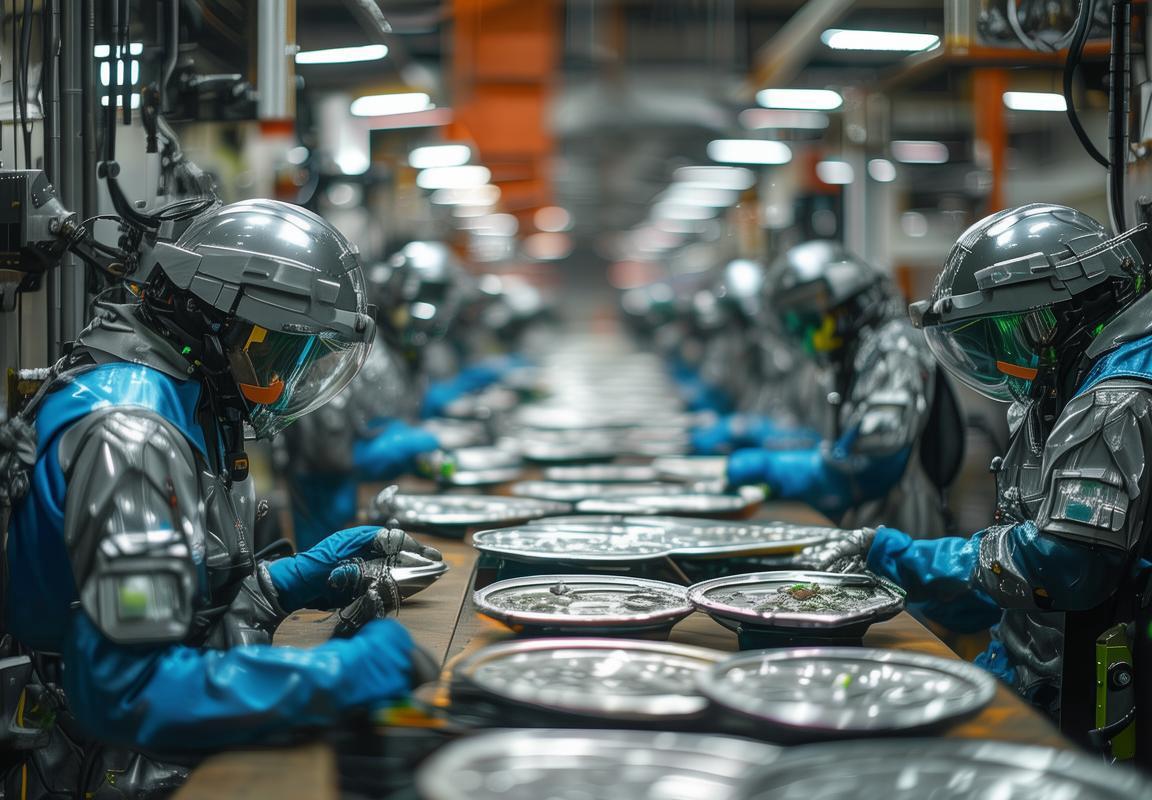In the ever-evolving landscape of kitchen appliance innovation, the integration of metal stamping technology has emerged as a pivotal force. This shift has not only revolutionized the production of sandwich plates but has also set new standards for efficiency, durability, and design in the European and American markets. As we delve into the intricate world of integrated metal stamping, it becomes clear that this technique is not just a fleeting trend but a cornerstone in the future of kitchen appliance manufacturing.
The Rise of Integrated Metal Stamping in Sandwich Plate Manufacturing
The manufacturing landscape of sandwich plates has undergone a significant transformation, largely driven by the advent and widespread adoption of integrated metal stamping. This innovative technique has revolutionized the way sandwich plates are produced, offering a blend of efficiency, precision, and cost-effectiveness.
Once a realm of basic, utilitarian designs, sandwich plates now boast intricate patterns and seamless finishes, all thanks to the advancements in metal stamping technology. The process involves shaping flat metal sheets into three-dimensional components, which are then assembled to create the sandwich plate structure. This method has become the go-to for many manufacturers due to its ability to produce complex geometries with high repeatability.
One of the key advantages of integrated metal stamping is the precision it offers. The technology allows for tight tolerances, ensuring that each plate meets the exact specifications required. This level of precision is crucial for ensuring that the sandwich plates are not only visually appealing but also functionally superior. The tight fit and uniformity of the parts contribute to the durability of the final product, which is a significant selling point in the kitchen appliance market.
In the European and American markets, where innovation and design are paramount, integrated metal stamping has become a cornerstone in the production of high-end kitchen appliances. The demand for sophisticated and sleek appliances has soared, and manufacturers have responded by leveraging metal stamping to create unique and attractive sandwich plate designs. These markets have seen a surge in the use of stainless steel and aluminum, materials that are not only aesthetically pleasing but also resistant to corrosion and heat.
The benefits of integrated metal stamping extend beyond aesthetics. The process is highly efficient, reducing the need for additional steps and materials. This efficiency translates into lower production costs and faster turnaround times. As a result, companies can offer competitive pricing without compromising on quality. The ability to mass-produce complex parts with minimal waste has also helped to drive down the cost of sandwich plates, making them more accessible to a broader consumer base.
As the demand for kitchen appliances continues to grow, so too does the need for innovative solutions in manufacturing. Integrated metal stamping has stepped up to fill this void, providing manufacturers with the tools they need to produce advanced sandwich plates that cater to both the aesthetic and functional needs of consumers. The technology allows for rapid prototyping, enabling designers to experiment with different shapes, sizes, and features without incurring excessive costs.
Moreover, the sustainability angle cannot be overlooked. Metal stamping is a green manufacturing process that minimizes energy consumption and reduces waste. This eco-friendly approach aligns with the growing consumer preference for environmentally conscious products. As more consumers seek out appliances that are both stylish and sustainable, the appeal of integrated metal stamping in sandwich plate production becomes even more pronounced.
However, the adoption of integrated metal stamping is not without its challenges. The initial investment in the stamping equipment can be substantial, and there is a learning curve for operators. But for those willing to invest, the rewards are substantial. The ability to create custom solutions for clients, the reduction in manual labor, and the overall improvement in product quality make the initial costs worthwhile.
Looking ahead, the future of integrated metal stamping in sandwich plate manufacturing looks bright. As technology continues to evolve, we can expect to see further advancements in material properties and production techniques. The potential for integrating smart features into sandwich plates, such as thermal sensors or anti-slip coatings, is also on the horizon. These innovations will not only enhance the functionality of kitchen appliances but also elevate the consumer experience.
In conclusion, integrated metal stamping has become a game-changer in the manufacturing of sandwich plates. Its ability to deliver high-quality, customized, and sustainable products has solidified its position as a key technology in the kitchen appliance industry. As consumer expectations continue to rise, it’s clear that the rise of integrated metal stamping is here to stay.

Understanding Sandwich Plates and Their Importance in Kitchen Appliances
Sandwich plates, often overshadowed by the sleek, futuristic designs of modern kitchen appliances, play a pivotal role in the functionality and longevity of these devices. These specialized components, which consist of two or more layers of metal with a non-conductive material in between, offer a blend of strength and insulation that is invaluable in today’s kitchens.
The core of a sandwich plate lies in its multi-layered structure. The outer layers are typically made of metal, which provides the necessary structural integrity and durability. The middle layer, often referred to as the insulating or core material, is non-conductive and serves to prevent heat transfer, an essential feature in appliances like cooktops and ovens. This insulation not only enhances the appliance’s efficiency but also protects users from potential burns.
In kitchen appliances, sandwich plates are integral to various functions. For instance, in electric cooktops, they distribute heat evenly across the surface, ensuring that food is cooked uniformly. In wall ovens, sandwich plates help maintain consistent temperatures, crucial for achieving perfect roasts and bakes. This technology is not just about heat management; it also contributes to the aesthetic appeal of the appliance, as sandwich plates can be designed to match the overall look of the kitchen.
The evolution of sandwich plates has been marked by a quest for innovation. Early iterations were often bulky and limited in design options, but advancements in technology have allowed for thinner, more versatile plates. The use of advanced materials, such as stainless steel for the outer layers and ceramics for the core, has not only improved performance but also expanded the range of applications.
One of the key benefits of sandwich plates is their ability to withstand high temperatures without deforming. This durability is a significant factor in the longevity of kitchen appliances, as it reduces the frequency of repairs and replacements. Additionally, the even heat distribution minimizes the risk of hotspots, which can lead to uneven cooking and potential damage to the appliance.
In terms of environmental impact, sandwich plates contribute to energy efficiency. By ensuring that heat is retained where it’s needed and not wasted, these plates help reduce energy consumption, making kitchen appliances more eco-friendly. This is particularly important as consumers become more conscious of their carbon footprints and the sustainability of their appliances.
The importance of sandwich plates is also reflected in the preferences of consumers. Modern buyers are not just looking for appliances that perform well; they are also seeking those that are safe, reliable, and aesthetically pleasing. Sandwich plates meet these criteria, as they offer a seamless blend of performance and design.
The market for sandwich plates has seen a surge in demand, driven by the growth of the kitchen appliance industry. As manufacturers continue to innovate and cater to the evolving needs of consumers, the demand for high-quality, efficient sandwich plates is likely to increase. This demand is also being influenced by the rise of smart kitchen technology, which requires advanced components like sandwich plates to function optimally.
Innovation in sandwich plate technology is not limited to the materials used. Techniques such as precision stamping and advanced welding have improved the manufacturing process, leading to higher quality and more consistent products. This has allowed manufacturers to produce sandwich plates that are tailored to the specific needs of different appliance models, ensuring optimal performance and compatibility.
In conclusion, sandwich plates are more than just components in kitchen appliances; they are critical elements that define the efficiency, safety, and aesthetics of these devices. Their significance is underlined by the continuous advancements in their design and materials, as well as the increasing consumer demand for high-performance, energy-efficient appliances. As the kitchen appliance industry continues to evolve, the role of sandwich plates will undoubtedly remain central to its success.

The Role of Integrated Metal Stamping in European and American Markets
The European and American markets have long been at the forefront of technological advancements, particularly within the kitchen appliance industry. Integrated metal stamping has emerged as a pivotal technology, revolutionizing the production of sandwich plates and other components. Here’s a closer look at how this process has become integral to these markets.
In the European market, the demand for high-quality, durable kitchen appliances has been consistently strong. This has driven manufacturers to seek innovative solutions to enhance the performance and lifespan of their products. Integrated metal stamping allows for the creation of intricate and precise sandwich plates, which are essential for the construction of reliable appliances.
The American market, known for its diverse consumer base, has seen a surge in the popularity of smart kitchen appliances. These devices require lightweight yet robust components to maintain functionality and aesthetic appeal. Integrated metal stamping provides the ideal material and production method to meet these requirements, ensuring that appliances are not only efficient but also user-friendly.
One of the key advantages of integrated metal stamping is its ability to produce complex shapes and sizes with minimal waste. This efficiency is particularly valuable in Europe, where environmental concerns are a significant factor in product development. By reducing material usage, manufacturers can contribute to a greener footprint and appeal to eco-conscious consumers.
In the American market, the emphasis on innovation often translates into the introduction of new features and designs. Integrated metal stamping enables the creation of unique sandwich plates that can accommodate these advancements, from sleeker profiles to enhanced heat distribution. This flexibility has become a cornerstone for manufacturers looking to differentiate their products in a crowded marketplace.
The precision of integrated metal stamping also plays a crucial role in the quality control process. European and American consumers expect their kitchen appliances to be reliable and safe, and the consistency achieved through stamping ensures that sandwich plates meet stringent quality standards. This has led to a reduction in product recalls and a boost in consumer confidence.
As technology continues to evolve, so does the sophistication of kitchen appliances. In Europe, the integration of smart features into kitchen appliances is becoming more prevalent, and integrated metal stamping is enabling the production of these advanced components. Similarly, in the U.S., the demand for energy-efficient appliances is growing, and stamping technology is essential for creating lightweight yet durable parts that contribute to lower energy consumption.
Another aspect of the integrated metal stamping process that has gained traction in both markets is the use of advanced materials. Titanium and stainless steel, for example, are increasingly being used in the production of sandwich plates due to their corrosion resistance and strength. This not only extends the lifespan of kitchen appliances but also aligns with the health and safety standards that European and American consumers demand.
The European and American markets also value customization. Integrated metal stamping allows for the creation of custom designs and specifications, catering to niche markets and individual preferences. Whether it’s a commercial kitchen or a high-end residential setting, the ability to tailor sandwich plates to specific needs is a significant advantage that has captured the attention of manufacturers and consumers alike.
In conclusion, integrated metal stamping has become a cornerstone technology in the European and American kitchen appliance markets. Its ability to produce high-quality, durable, and customizable components has driven innovation and efficiency, ultimately enhancing the consumer experience. As these markets continue to evolve, it’s clear that the role of integrated metal stamping will only grow more significant in shaping the future of kitchen appliances.

Benefits of Integrated Metal Stamping for Sandwich Plates
Integrated metal stamping has revolutionized the manufacturing process of sandwich plates, offering a multitude of benefits that have become indispensable in the European and American markets. From enhanced durability to improved design flexibility, here’s a closer look at the advantages that this technology brings to the table.
Precision and ConsistencyOne of the most notable benefits of integrated metal stamping in sandwich plate production is the unparalleled precision it offers. The process involves the use of high-pressure dies to shape metal sheets into complex shapes, ensuring that each sandwich plate is uniform in design and function. This level of consistency is crucial in the European and American markets, where consumers expect top-notch quality and reliability.
Durability and LongevityThe robust nature of metal stamping contributes significantly to the durability of sandwich plates. These plates are designed to withstand the rigors of daily use, from heavy loads to thermal variations. The metal stamping process allows for the creation of thicker and stronger walls, reducing the likelihood of cracks, dents, or warping over time. This durability is a major selling point in regions like Europe and the US, where consumers are willing to invest in long-lasting products.
Design VersatilityMetal stamping technology enables a wide range of design possibilities for sandwich plates. Whether it’s intricate patterns, varying thicknesses, or customized dimensions, the process allows for the creation of unique and aesthetically pleasing products. This versatility is particularly valuable in the European and American markets, which are known for their emphasis on innovation and consumer preferences.
Efficient ProductionEfficiency is key in the kitchen appliance industry, and integrated metal stamping delivers on this front. The stamping process is highly automated and can produce a large number of sandwich plates in a short amount of time. This not only reduces production costs but also minimizes waste. In the competitive European and American markets, where speed-to-market is critical, this efficiency is a significant advantage.
Cost-EffectivenessWhile the initial investment in metal stamping machinery can be substantial, the long-term cost savings are substantial. The process reduces the need for manual labor and minimizes the risk of defects, leading to lower production costs. Additionally, the longevity of the stamped parts means fewer replacements are needed, further reducing costs. In the cost-conscious European and American markets, this cost-effectiveness is a major draw for manufacturers and consumers alike.
Reduced Weight and Material UsageThrough advanced stamping techniques, sandwich plates can be designed with reduced material thickness without compromising strength. This not only lightens the overall weight of the plates but also optimizes material usage. Lightweight and eco-friendly products are increasingly favored in the European and American markets, making this a significant benefit for manufacturers looking to cater to these markets.
Enhanced AestheticsThe aesthetic appeal of kitchen appliances is a key factor in consumer purchasing decisions. Integrated metal stamping allows for intricate and visually appealing designs, which can greatly enhance the look of sandwich plates. This is particularly important in the European and American markets, where the kitchen is often considered a centerpiece of the home and where the aesthetic appeal of appliances is highly valued.
Improved Heat DistributionFor sandwich plates designed for cooking, heat distribution is crucial. The precision and consistency of metal stamping ensure that the plates can be crafted with features that improve heat distribution, such as hollowed-out areas or specific patterns. This not only enhances cooking performance but also contributes to the longevity of the plate by reducing the risk of hotspots that can damage the surface over time.
Ease of Cleaning and MaintenanceThe smooth and uniform surfaces achieved through metal stamping make sandwich plates easier to clean and maintain. Consumers in the European and American markets are always looking for appliances that are not only functional but also practical, and the ease of cleaning is a significant factor in their purchasing decisions.
Customization for Market SpecificsEuropean and American markets often have unique requirements and preferences. Integrated metal stamping allows for the customization of sandwich plates to meet these specific needs, whether it’s adhering to certain safety standards or incorporating features that resonate with local consumer tastes.
In conclusion, the benefits of integrated metal stamping for sandwich plates are multifaceted, offering manufacturers in the European and American markets a competitive edge. From precision and durability to design versatility and cost-effectiveness, this technology is reshaping the landscape of kitchen appliance manufacturing.

Market Trends and Consumer Preferences in the Western Kitchen Appliances Sector
In recent years, the Western kitchen appliances sector has undergone a remarkable transformation, driven by evolving market trends and shifting consumer preferences. This dynamic landscape has several key factors shaping its direction.
The surge in health consciousness has prompted a demand for kitchen appliances that offer convenience without compromising nutritional value. Consumers are increasingly seeking appliances that not only save time but also provide options for healthier cooking methods.
Smart kitchen technology is becoming a staple in many Western homes. From internet-connected fridges to voice-controlled ovens, the integration of smart features has allowed for greater control, efficiency, and convenience in cooking and meal preparation.
Eco-friendly and sustainable appliances are gaining traction as consumers become more environmentally aware. Brands that prioritize energy efficiency, recyclable materials, and low carbon footprints are likely to see increased market share.
The kitchen appliances sector is witnessing a rise in multi-functional devices. Appliances that can perform multiple tasks, such as an oven that can also roast and bake, or a blender that can grind coffee and make smoothies, are appealing to those looking to streamline their kitchen equipment.
Personalization and customization are becoming more prevalent in the market. Customers are looking for appliances that can be tailored to their specific needs, whether it’s a particular size, color, or unique functionality.
The trend towards compact and space-saving appliances is on the rise, especially in urban environments where space is at a premium. Mini-fridges, countertop ovens, and compact dishwashers are becoming increasingly popular.
The Western consumer’s preference for high-quality materials is evident in the market. From stainless steel appliances to those made with high-end finishes like ceramic or glass, there’s a clear emphasis on durability and aesthetic appeal.
Energy-saving features are a must-have for many consumers. The demand for appliances that are energy-efficient has grown significantly, reflecting a broader environmental consciousness and the desire for cost savings over time.
Design and style are not just superficial considerations; they are integral to the purchasing decisions of many Western consumers. Appliances that offer modern, sleek designs and are adaptable to various kitchen decors are more likely to catch the eye of shoppers.
As the Western kitchen appliances sector continues to evolve, there’s an increasing focus on user experience. Appliances that are intuitive to use, with easy-to-navigate controls and ergonomic designs, are becoming more attractive to consumers.
The demand for appliances that can be integrated with other smart home systems is also growing. Consumers are looking for seamless connectivity, allowing their kitchen appliances to work in harmony with other smart devices in their homes.
The trend towards convenience extends beyond just the appliances themselves. Features like pre-programmed settings, automatic ordering of replacement parts or consumables, and even hands-free operation are becoming more sought after.
The rise of the “foodie” culture has influenced the Western kitchen appliances market. Appliances that cater to culinary enthusiasts, such as high-end ranges, sous-vide machines, and precision cookers, are becoming more accessible to the average consumer.
Lastly, the after-sales service and customer support play a significant role in consumer preferences. Brands that offer robust warranties, reliable customer service, and easy access to spare parts are likely to build stronger customer loyalty.

Case Studies: Successful Implementations of Integrated Metal Stamping in Sandwich Plates
In the world of kitchen appliances, the integration of metal stamping into sandwich plate manufacturing has become a game-changer. Let’s delve into a few case studies that highlight the successful implementations of this innovative technology.
The integration of metal stamping in sandwich plates for a leading European appliance manufacturer has significantly boosted their product line. By using this process, they were able to create lightweight, yet sturdy plates that could withstand the rigors of everyday kitchen use.
One American company specializing in high-end cookware took a bold step by incorporating integrated metal stamping into their sandwich plates. This move not only enhanced the aesthetic appeal of their products but also allowed for the creation of intricate designs that were previously unattainable with traditional manufacturing methods.
A mid-sized appliance brand in the UK faced the challenge of reducing costs without compromising on quality. By switching to integrated metal stamping for their sandwich plates, they were able to streamline their production process, resulting in lower production costs and improved efficiency.
In another case, a well-known global kitchen appliance brand sought to differentiate their sandwich plates from competitors. Through the use of metal stamping, they introduced a unique, sleek design that not only caught the eye of consumers but also increased their brand’s market share.
A small, family-owned business in Canada found that integrating metal stamping into their sandwich plates allowed them to offer a more customized product. They could now cater to specific market niches, such as eco-friendly and energy-efficient appliances, by tailoring the materials and designs to their customers’ preferences.
For a South American manufacturer, the adoption of integrated metal stamping was a strategic move to increase their competitive edge. By producing sandwich plates with superior quality and durability, they were able to establish themselves as a premium brand in the region.
A European startup that focuses on smart kitchen appliances used integrated metal stamping to create plates that are not only functional but also interactive. Their innovative sandwich plates can be controlled via a smartphone app, allowing users to monitor cooking times and temperatures remotely.
An Asian appliance manufacturer found that integrating metal stamping into their sandwich plates helped them to achieve a high degree of precision. This precision allowed them to create plates with tight tolerances, ensuring a perfect fit for various cookware types.
In the US, a company known for its outdoor kitchen appliances faced the challenge of creating sandwich plates that could withstand harsh weather conditions. By utilizing metal stamping, they were able to produce plates that were both durable and resistant to corrosion, making them ideal for outdoor use.
A German kitchen appliance brand sought to improve the energy efficiency of their sandwich plates. Through the use of metal stamping, they developed plates with better thermal conductivity, leading to faster and more even heat distribution.
A Canadian company specializing in commercial kitchen equipment found that integrated metal stamping allowed them to produce sandwich plates that were both lightweight and capable of withstanding heavy-duty use in professional kitchens.
In the UK, a brand known for its high-quality cast iron cookware incorporated metal stamping into their sandwich plates to offer a new, innovative product line. This new line featured plates with improved heat retention and a unique, rustic design.
An Australian appliance manufacturer focused on sustainable living embraced metal stamping to create sandwich plates made from recycled materials. This move aligned with their brand’s commitment to the environment and appealed to eco-conscious consumers.
In conclusion, the case studies of successful implementations of integrated metal stamping in sandwich plates demonstrate the versatility and benefits of this technology across various markets and applications. From enhancing aesthetics to improving functionality, metal stamping has proven to be a valuable tool in the kitchen appliance industry.

Challenges and Solutions in Adopting Integrated Metal Stamping Technology
Transitioning to integrated metal stamping technology can be a transformative step for manufacturers, yet it’s not without its fair share of challenges. Here’s a detailed look at some of the common hurdles faced and the innovative solutions that have emerged.
In the adoption of integrated metal stamping, one significant challenge is the initial investment required for the necessary equipment and training. The upfront costs can be substantial, particularly for smaller businesses that are just starting to explore this technology. However, many companies have overcome this by seeking government grants or tax incentives designed to support the adoption of advanced manufacturing techniques.
Another challenge is the complexity of the stamping process itself. It demands a high level of precision and skill, which can be difficult to achieve without experienced personnel. Companies have tackled this by investing in continuous employee training programs and bringing in seasoned experts who can mentor their teams. This not only improves the quality of the products but also ensures a smoother transition to the new technology.
The need for custom tooling is another challenge that arises when integrating metal stamping. Each component requires a specific tool, and the cost of these tools can be prohibitive. To address this, some manufacturers have turned to collaborative tooling, where they share the cost and responsibility of tooling with other companies producing similar parts. This approach can significantly reduce the financial burden and time to market.
Maintaining consistency in the stamping process is crucial, but it can be challenging due to variations in material thickness and surface conditions. Advanced quality control measures, such as inline gauging systems and automated inspections, have been implemented to ensure that every part meets stringent quality standards. These systems can detect deviations early in the process, preventing defects from reaching the final product.
The integration of metal stamping into existing production lines can also pose a challenge. Compatibility issues and the need for space can disrupt current workflows. Many companies have managed this by investing in flexible manufacturing systems that can adapt to the new technology without requiring a complete overhaul of their production facilities. This allows for a gradual transition that minimizes downtime and keeps costs in check.
The environmental impact of manufacturing processes is a growing concern, and metal stamping is no exception. One challenge is the energy consumption and waste generated during the stamping process. Companies have responded by investing in energy-efficient machinery and implementing recycling programs to reduce their environmental footprint. This not only helps to mitigate the impact on the planet but can also lead to cost savings over time.
Safety is another critical challenge in the adoption of integrated metal stamping. Operators must be protected from the hazards of the stamping process, which can include flying debris, high-pressure tools, and loud noise. Companies have addressed this by implementing comprehensive safety protocols, including regular equipment maintenance, personal protective equipment (PPE), and ongoing safety training for employees.
The integration of metal stamping technology often requires a shift in the mindset of the workforce. Employees may be accustomed to traditional manufacturing methods and may resist change. To overcome this, manufacturers have engaged in change management initiatives that help employees understand the benefits of the new technology and provide them with the training and support they need to adapt successfully.
In conclusion, while the adoption of integrated metal stamping technology comes with its set of challenges, the solutions that have been developed are multifaceted and innovative. From financial strategies to quality control measures, safety protocols to change management, these solutions demonstrate that with careful planning and execution, the challenges of integrating new technology can be effectively managed.

Predictions for the Future of Integrated Metal Stamping in Sandwich Plate Production
In the evolving landscape of sandwich plate production, the integration of metal stamping technology promises a transformative wave of innovation. As we gaze into the horizon, several key trends and potential developments emerge, shaping the future of this industry.
Technological advancements are paving the way for more sophisticated stamping processes. The ability to create intricate and lightweight designs with high precision will likely become standard, enhancing the performance and aesthetic appeal of sandwich plates.
The demand for sustainable materials and practices is growing. With environmental concerns at the forefront, we can expect a shift towards eco-friendly metal stamping techniques that minimize waste and energy consumption.
The integration of smart technologies within the stamping process is on the rise. This could include sensors and automated systems that monitor quality control and optimize production efficiency, leading to a more streamlined and responsive manufacturing process.
Customization is becoming increasingly important. As consumers seek unique and personalized kitchen appliances, the stamping industry will need to adapt by offering a wider range of customizable designs and features for sandwich plates.
Collaboration between stamping companies and material suppliers will become crucial. The development of new metals with enhanced properties, such as higher strength-to-weight ratios, will require close partnerships to ensure the materials are compatible with stamping processes.
The global market for sandwich plates is expanding rapidly. This growth is not confined to a single region but is a global phenomenon. As a result, the demand for cost-effective and efficient production methods like integrated metal stamping will only intensify.
Regulatory changes in various countries may impact the way sandwich plates are manufactured. Compliance with new environmental and safety standards will necessitate the adoption of more advanced and sustainable stamping technologies.
Innovation in material science is likely to drive the future of integrated metal stamping. New alloys and coatings could offer improved heat resistance, corrosion protection, and durability, making sandwich plates more versatile and long-lasting.
The integration of AI and machine learning into the production line is poised to revolutionize quality assurance. Predictive maintenance and real-time monitoring will reduce downtime and increase the overall reliability of the stamping process.
Energy efficiency remains a focal point. As manufacturers strive to reduce their carbon footprint, the adoption of energy-saving stamping technologies will become more prevalent, ensuring that sandwich plates are produced with a lower environmental impact.
The rise of e-commerce and direct-to-consumer sales channels may influence the way sandwich plates are produced and distributed. Smaller batch production and just-in-time manufacturing could become more common, allowing for faster response to market demands.
The focus on user experience will continue to influence the design and functionality of sandwich plates. As consumers value convenience and ease of use, the stamping industry will need to develop products that are not only durable but also user-friendly.
Collaborative design processes, involving input from engineers, designers, and end-users, will likely become more prevalent. This holistic approach will ensure that sandwich plates are not only aesthetically pleasing but also functional and adaptable to various kitchen environments.
As the world becomes more interconnected, the stamping industry will face new challenges and opportunities. The exchange of knowledge and technology across borders will foster innovation and drive the standardization of stamping processes.
Ultimately, the future of integrated metal stamping in sandwich plate production looks promising. With a focus on efficiency, sustainability, and consumer needs, the industry is poised for significant growth and advancement.

Conclusion: The Impact of Integrated Metal Stamping on Kitchen Appliance Innovation
The integration of metal stamping technology into sandwich plate production has revolutionized the kitchen appliance industry. This innovative approach has not only enhanced the functionality and durability of these components but has also paved the way for a new era of design possibilities. As we reflect on the impact of integrated metal stamping, several key outcomes stand out.
Materials and EfficiencyMetal stamping allows for the creation of sandwich plates with precise and consistent dimensions, which is crucial for the overall efficiency of kitchen appliances. The ability to use various metals, including stainless steel and aluminum, means that these components can be tailored to meet specific thermal and structural requirements. This flexibility in materials has led to a significant reduction in energy consumption and waste, as appliances become more energy-efficient and sustainable.
Design and CustomizationThe advent of integrated metal stamping has opened up new frontiers in design. With the ability to shape complex patterns and intricate details, manufacturers can produce sandwich plates that are not only functional but also aesthetically pleasing. This has translated into a surge in personalized and modern kitchen appliances, catering to consumers who value both form and function.
Cost-EffectivenessDespite the precision and complexity of the stamping process, it has proven to be cost-effective in the long run. The high-speed production of metal stamped parts reduces labor costs and minimizes the need for additional finishing processes. This cost advantage has enabled manufacturers to offer more affordable yet high-quality kitchen appliances to a wider market segment.
Durability and LongevityOne of the most significant impacts of integrated metal stamping is the increased durability of sandwich plates. The strength and stability of the stamped components ensure that kitchen appliances are more resistant to wear and tear, leading to longer product lifespans. This not only enhances customer satisfaction but also reduces the environmental impact of frequent replacements.
Innovation and Market ExpansionThe integration of metal stamping technology has spurred innovation within the kitchen appliance sector. New designs and functionalities are being introduced at a rapid pace, leading to market expansion. The ability to produce intricate and lightweight sandwich plates has allowed for the development of compact and high-performance appliances, appealing to a diverse range of consumers.
Regulatory Compliance and SafetyThe precision of metal stamping ensures that sandwich plates meet stringent regulatory standards for safety and performance. This is particularly important in kitchen appliances, where the integrity of components directly impacts user safety. The consistent quality of stamped parts has become a benchmark for compliance with international safety protocols.
Consumer Perception and Brand ReputationThe use of integrated metal stamping in sandwich plates has positively influenced consumer perception of kitchen appliances. The perceived quality and reliability of these appliances have bolstered brand reputations, making them more attractive to consumers who seek premium products. This shift in consumer sentiment has, in turn, driven demand for innovative and technologically advanced kitchen appliances.
Future ProspectsLooking ahead, the future of integrated metal stamping in sandwich plate production is bright. Advances in stamping techniques and materials are expected to further enhance the capabilities of this technology. The potential for integrating smart features into sandwich plates is also a promising area for development, as the kitchen appliance industry continues to evolve towards smart and connected homes.
In conclusion, the impact of integrated metal stamping on kitchen appliance innovation is profound. It has not only improved the performance and lifespan of appliances but has also fueled creativity and efficiency in design and production. As the technology continues to advance, the kitchen appliance sector is poised to experience even more groundbreaking developments, ultimately enriching the lives of consumers worldwide.